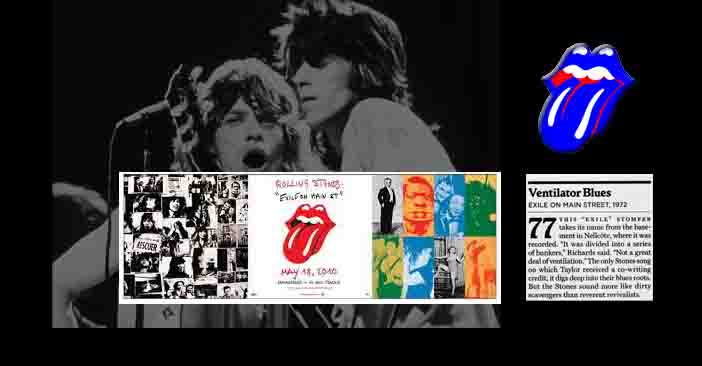
The story, anecdotes, clips, backstage behind the recording of Exile On Main Street in Villa Nellcote, album released on May 1972
The making of the Rolling Stones’s Exile on Main Street is a rock legend. But what really happened in those long weeks of 1971? Lets looks back at a drug-fuelled marathon that still haunts the Côte d’Azur. To read the full story click here
Tumbling Dice began its life in 1969, originally under the title “Good Time Women.”
“It was one of those songs with a very simple structure that evolved out of us just jamming,” guitarist Mick Taylor noted to Blender magazine. “It even had an early vocal with completely different words.”
“Good Time Women” was one of the ideas the band brought with them to the Nellcote mansion in the South of France in 1971, where they recorded Exile on Main St. while avoiding the U.K.’s hefty upper class income tax. (UCR)
The famous sessions featured the band working in the property’s basement, recording in gruelingly hot and humid conditions.
“It was 120 degrees,” Keith Richards later recalled. “Everyone sat around sweating and playing with their pants off.”
“The humidity was incredible. I couldn’t stand it,” added Mick Jagger. “As soon as I opened my mouth to sing, my voice was gone. It was so humid that all the guitars were out of tune by the time we got to the end of each number.”
Almost as exhausting as the heat: the pace at which the Stones worked.
“They would play for days without coming in and listen[ing] to anything,” recording engineer Andy Johns noted in the book Rocks Off: 50 Tracks That Tell the Story of the Rolling Stones.
Los Angeles also played a major part in Exile‘s creation, on multiple levels, says Keith Richards. wearing mirrored shades, red shirt and leather jacket while puffing a joint and standing inside a Bel-Air Spanish revival home, Keith Richards put his hands together to form a folded shape. “We can make some postcards,” he said. Then he fell to the floor, zonked.
It was Jagger who hand-lettered Exile’s titles and credits, using pens and paper Van Hamersveld had sent him. “And then those pieces of paper I pasted down, with tape, so that’s how you get that rough look. It doesn’t come from a typographer — it comes from Mick Jagger, with a pen in his hand.” (K.R.)
Indeed, even when inspiration struck, the process would get drawn out. The riff in “Tumbling Dice” is a perfect example.
“I remember writing the riff upstairs in the very elegant front room, and we took it downstairs the same evening and cut it,” Richards recalled. “A lot of times when ideas come that quick, we don’t put down lyrics — we do what we call ’vowel movement.’ You just bellow over the top of it to get the right sounds for the track.”
Though the song’s structure was coming together, it took a long time to get the tune just right.
“We worked on that for a couple of weeks at least, just the basic track,” noted Johns. “I know we had a hundred reels of tape on the basic track.” The exact number of takes the band laid down is unknown, but some have estimated it around 150 tries.
“That was a good song,” Johns admitted, “but it was really like pulling teeth. It just went on and on and on.”
As one half of the fabled Glimmer Twins, Keith Richards doesn’t make many solo albums. Still, it could be argued that one of them helped save the Rolling Stones. His gold-selling ‘Talk is Cheap’ LP arrived in 1988 Keith Richards’s first solo album in 23 years is surprisingly compelling. Backed, as he was in 1992, by the

 X-Pensive Winos, Richards mixes uptempo blues (Blues in the Morning) with more introspective fare where his gravelly delivery has much in common with Mark Lanegan (as well as one misguided venture into lukewarm reggae). Pleasingly, Heartstopper and the standout Trouble suggest he hasn’t forgotten how to write killer riffs when the mood takes him. By the end, you find yourself wishing he was just a little more prolific.
X-Pensive Winos, Richards mixes uptempo blues (Blues in the Morning) with more introspective fare where his gravelly delivery has much in common with Mark Lanegan (as well as one misguided venture into lukewarm reggae). Pleasingly, Heartstopper and the standout Trouble suggest he hasn’t forgotten how to write killer riffs when the mood takes him. By the end, you find yourself wishing he was just a little more prolific.
Richards made it to the big screen in 2007 with a small role in Pirates of the Caribbean: At World's End. In the film, he played the father of Johnny Depp's popular pirate Captain Jack Sparrow—a character partially inspired by Richards.
In October 2010 Richards released his autobiography, Life. The book revealed he is an avid reader and owns a vast collection of literary work as well as chronicling his reflections on the rock star world, drug busts, the women in his life and his relationship with Jagger. With a legendary run in the 1960s, the Stones went on to create more hit albums in the '70s and '80s, including Sticky Fingers (1971), Exile on Main St. (1972), Emotional Rescue (1980) and Tattoo You (1981).
About "Life" book: The book was generally well received by critics, with several commenting on the honesty of the work. Charles Spencer of The Daily Telegraph wrote, "Life offers much more than vicarious thrills. It captures the true spirit of rock and roll, the nitty-gritty of life on the road, and just what it feels like to be a heroin addict who doesn't know where his next fix is coming from. It also movingly captures Richards' extraordinary love of music—an even more powerful addiction for him than smack—and perhaps more surprisingly, his manifest destiny as a human being." Jim Fusilli of the Wall Street Journal said that "Mr.  Richards writes with disarming introspection about his childhood, family and fame. And it's quite likely that no rock musician has ever written so keenly about the joys of making music.
Richards writes with disarming introspection about his childhood, family and fame. And it's quite likely that no rock musician has ever written so keenly about the joys of making music.
